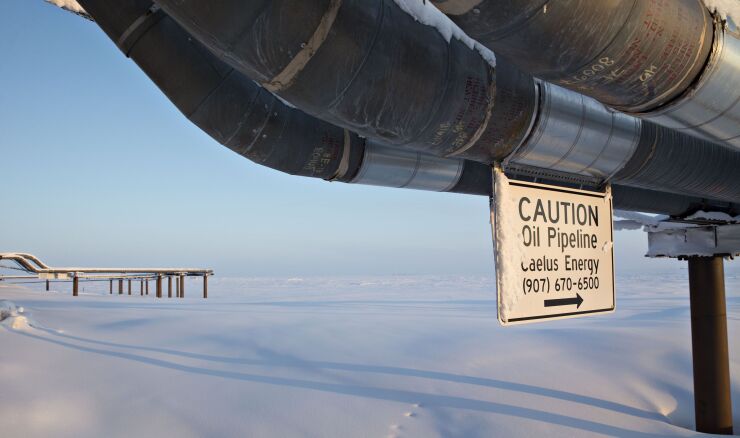After the stunning collapse of some oil futures prices into negative territory Monday, energy producing states are struggling to adjust budgets for the coming months and the next fiscal year.
“While this unprecedented volatility is concerning, the greater impact to Texas will come if demand remains historically low for a prolonged period of time and supply gluts continue to strain storage capacity,” state Comptroller Glenn Hegar said in a statement about the price collapse.

Hegar said that reduced severance tax collections on oil and gas would primarily affect the state’s Rainy Day Fund and State Highway Fund, and to a lesser extent general revenue available to meet budget needs. Contraction in the energy industry also will affect other sources of tax revenue, including sales and franchise taxes, he said.
“The Texas budget is based on the average price of oil in each year of the biennium, thus daily market activity doesn’t significantly affect revenues, which are forecast based on average prices rather than spot prices or prices for specific futures contracts,” he said. “Given the historic nature of today’s market moves, we are carefully monitoring trading as June contracts come into focus. Should prices remain depressed over a long period of time, we anticipate the impact will be reflected in a reduction in the revenue forecast we'll be releasing in July."
As the price of West Texas Intermediate crude for May delivery was plunging to a low of nearly negative $38 Monday, Oklahoma’s Board of Equalization held a virtual meeting that led to declaration of $416.9 million revenue failure for the current fiscal year.
The board's February report provided $8.244 billion of spending authority for the Legislature, but the latest projection shows just $6.878 billion available, a difference of $1.366 billion.
The meeting came as Oklahoma lawmakers struggle to write a budget for the 2021 fiscal year that begins July 1.
“Even if we took our savings account down to zero, we would still have 7.5% less to spend than in FY20, and we’ll likely have another significant drop for FY22,” said Gov. Kevin Stitt. “These are difficult times for people across our state, and I want the Legislature and Oklahomans to have the latest information as we work on next year’s budget.”
North Dakota Gov. Doug Burgum called an emergency meeting of the Industrial Commission to consider an order to classify oil and gas produced at a loss to be considered a waste.
“Many of our members are being told they cannot deliver crude in May due to storage constraints, and as a result have begun planning to shut in 100% of their Louisiana production,” Louisiana Oil & Gas Association President Gifford Briggs said in a statement Monday.
“It’s an absolute worst case scenario, a perfect storm,” he said. “The crisis facing the industry is impossible to overstate.”
Prices for June and July delivery oil futures continued to plummet on Tuesday.
Statewide Louisiana lost 1,100 jobs in mining and logging, which includes the oil and gas sector, over the past 12 months through March, a decline of 2.9% to 35,600 jobs.
About 450 members of LOGA surveyed in recent weeks estimated that about half of the wells in the state could be shut in as a result of the economic downturn. That was when oil was hovering around $20 per barrel.
There are 33,650 oil and gas wells operating in Louisiana. There are only 41 oil and gas rigs actively drilling for oil and natural gas across the state, including 24 on land and the remainder in the Gulf of Mexico, according to Baker Hughes data as of April 17.
Considered the most oil-dependent state, Alaska took an S&P Global Ratings downgrade to AA-minus from AA and retained a negative outlook on Friday, before prices fell below zero.

"Impacts to Alaska of this particular low price will be based on average prices over the course of the month, and most deals being done for Alaska North Slope crude are currently focused on June delivery, not May," said Dan Stickel, chief revenue economist for the state. "However, the big picture fundamental drivers are absolutely concerning for Alaska — until there is a rebalancing of supply and demand globally we are likely to continue to see pressure on prices."
The Alaska budget for the fiscal year beginning July 1 was completed on March 28 when the price of Alaska North Slope crude oil was $24.46 per barrel. Petroleum revenue used to account for 90% of the state’s annual unrestricted general fund revenue. In FY21, petroleum revenue is projected to account for just 17% of the budget at a forecasted price of $37 per barrel.
With its coal industry in a deep recession, Wyoming was already in dire straits before the bottom fell out of the oil market, according to a memo to lawmakers from the Legislative Service Office. The April 14 memo estimated that revenues could fall between $555 million and $2.8 billion over the next two years.
“It is an overwhelming, massive shock to the way Wyoming’s operated for 100 years, and it will be the most dynamic, painful change the state has ever had to deal with,” said House Revenue Committee Chairman Dan Zwonitzer, R-Cheyenne.





